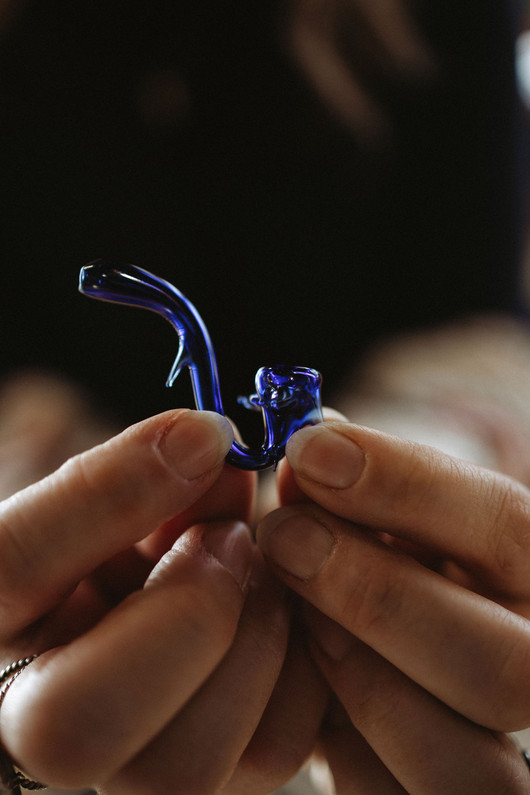Guide for Buying a Handpipe
Pipe, hand pipe, or spoon - there are many names for a simple hand pipe. They are the most common device used for consuming cannabis. Hand pipes are designed to sit in the palm of your hand and are composed of a bowl in which you pack the flower and a stem from which you inhale the smoke. With so many styles available, we want to make it easy to choose the best hand pipe for you. We breakdown each material type, complete with a list of pros and cons.

Made from 100% Borosilicate Glass, this pipe is the most widely recognized for its use as a cannabis pipe. The first official glass pipe was patented in 1977, but did not become popular until the 90's, when companies like Northstar Glass started producing coloured glass rods on an industrial level, making it more accessible for glass artists. Now a days, glass pipes are everywhere. Production glass pipes are manufactured in large warehouses overseas and appear to be very affordable. Hand blown artist made glass pipes are widely recognized and set a higher standard than production glass for a few reasons. Firstly, the raw material is a higher quality, it's sourced from reputable companies, and the love and attention to detail the artist will put into their craft sets them apart. Lastly, a glass artist will anneal their finished piece for a long period of time in a kiln, whereas production warehouses can rush this step or disregard it completely. We can't give you a brief history of glass pipes and not mentioned the "Godfather" Bob Snodgrass who began flameworking in the 1970's, travelling in his glassblowing bus on tour with The Grateful Dead, spreading awareness of the art form.
PROS:
- Easy to Clean
- Low Heat Retention
- Zero Emissions
- Maintains Flavour Profile
- Can Last Forever if cared for
- Does not degrade
CONS:
- Breakable under the right conditions ?

While we grouped all metal pipes together, there are many materials in this group including brass, nickel and anodized aluminum pipes.
PROS:
- Virtually Unbreakable (Rubber seals can dry out in certain climates)
- Low Maintenance
- Affordable ?
CONS:
- High Emissions
- Metallic Taste
- Higher Heat Retention

A wide variety of woods are used to make a hand pipe. From more simple materials such as: Briar, Corn Cob, Meerschaum to more exotic woods like: Bubinga, Padauk, Brazilian Cherry, Rosewood, Hard Maple and many more.
PROS:
- Hard to Break
- Low Emissions
- Maintains Flavour Profile
CONS:
- Harder to Clean
- Requires Natural Solution Cleaner and Pipe Cleaners
- Porous Material ? - Takes longer to fully dry out
![]()
Silicone is one of the newest additions to the mainstream pipe world. Almost any shape is achievable with silicone: from your standard spoon to your favourite food or cartoon character. Available in a wide variety of colours and sizes, too. The main hand pipe body will be 100% food grade silicone with either a metal or glass bowl insert.
PROS:
- Indestructible
- Withstands High Heat ? (Up to 500°F) and Freezing ❄️ Temperatures
- Easy to Clean - Use hot water and/or natural solutions
- Affordable ?
CONS:
- Overall taste and feel may not appeal to everyone
- Avoid if you have pets who shed ? ? ? ?

Ceramic pipes are made from clay, which is then kilned at very high temperatures. These pipes can appear either very simple, or simply exquisite.
Stone + Crystal Pipes
Stone and crystal pipes are one the oldest pipe materials used, dating all the way back to 4000BC. The most common stone pipes are made out of onyx, soapstone and pipestone. Durable, portable, and each one unique, stone pipes have many advantages as it doesn't alter the taste of your smoke. Smoking from stone tastes clean and full flavoured, just like from glass.
PROS:
- Clean
- Low Heat Retention
- Maintains Flavour Profile
CONS:
- Breakable under the right conditions ?
From glass to silicone, there is a perfect pipe for everyone. As a trusted accessories supplier in Calgary for 19 years. We take the time to find the right fit that works best for your lifestyle, elevating your experience to The Next Level.





